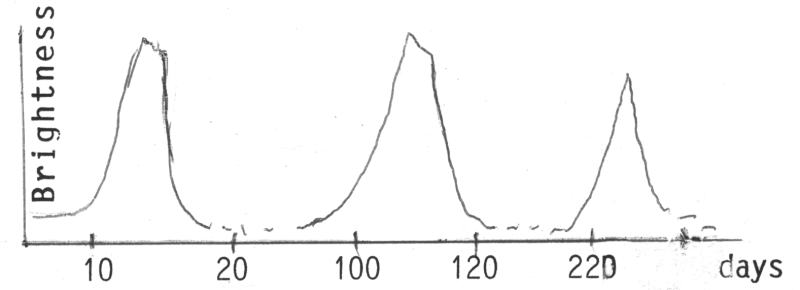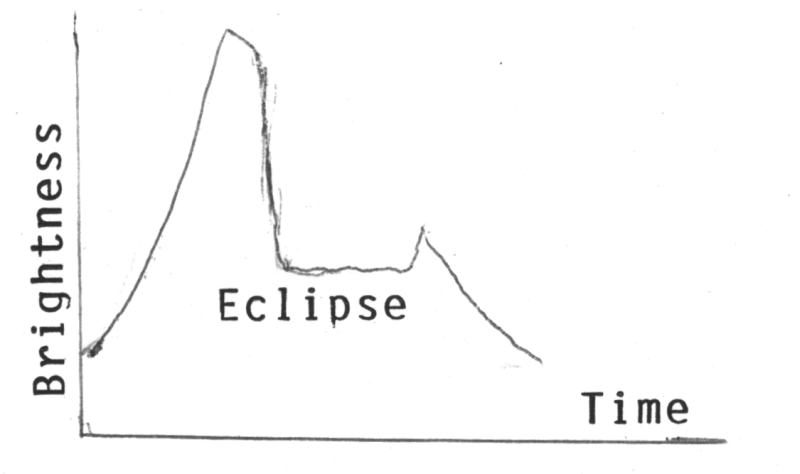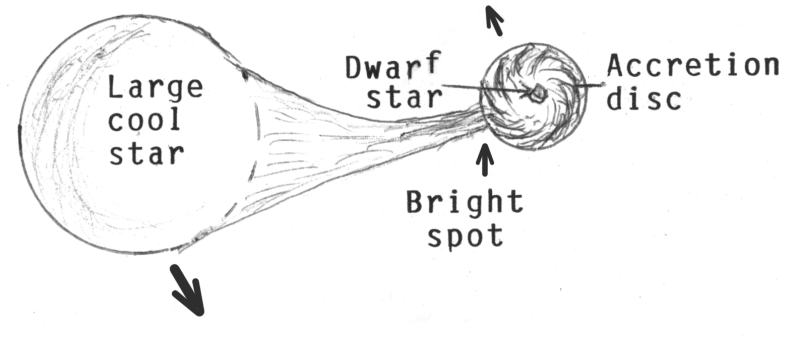
Under the class of stars typified as peculiar variables are the cataclysmic variables or eruptive variables. They are dwarf stars that undergo sudden changes in brightness. The best known example is U Geminorum and these stars are also called U Geminorum stars. U Geminorum is situated at right ascension 07h 54m and declination north 22° 01'. Whereas the R Coronae Borealis variables suddenly decrease in brightness through 2 to 6 magnitudes because of the carbon dust that they expel, the U Geminorum stars suddenly brighten by 2 to 6 magnitudes.
In July 1855 U Geminorum suddenly became nine magnitudes brighter and disappeared after two weeks. A few months later N R Pogson found that it had returned to its former brightness and then it slowly faded. Because the sudden brightening gives these stars the appearance of being new stars, they are called novae (pronounced "novy"). Those such as U Geminorum and Z Camelopardalis which usually have small eruptions are called dwarf novae.

The light curve of U Geminorum consists of a series of peaks. The brightness lasts about twenty days followed by about 100 days of quiescence. There is a linear relationship between the amplitudes and the periods of the dwarf novae: the greater the change in brightness, the longer the period.
Spectroscopically it has been found that the majority of these stars are close binaries in which streams of gas flow from a cool, solar type of star to a dwarf companion. Because of their proximity to each other, it often happens that these stars eclipse each other and that with each revolution a sudden brightening takes place, lasting for about one-fifth of the period of variability. This is due to the fact that gas streams from the larger, cool star form an accretion disc around the dwarf, which is usually a white dwarf. The light curve thus shows a sudden drop just after maximum brightness.

The sudden brightening itself is due to the heating which takes place at the point where the gas streams hit the accretion disc. As these stars revolve around each other, the bright spot becomes eclipsed as shown in the diagram.
Eruptions of dwarf novae take place at random.
The brightening of the bright spot on the accretion disc can vary according to the temperature of the

impinging gases from the large star. The orbits of the stars are usually circles but many are elliptical.
The stars have emission lines in their spectra as they approach maxima in their light curves. This is due to the great speed of 3000 km s-1 with which the accretion disc rotates.
Usually the more massive member of the pair evolves away from the main sequence on the Hertzsprung-RusseIl diagram towards the giant area. While expanding in becoming a giant, the star sheds its upper layers of gas and these shells of gas are absorbed by the lighter member of the pair so that it gains mass. After the member which has lost a certain amount of gas while leaving the main sequence, it shrinks down to a white dwarf due to its own gravity. By this time the originally less massive star has gained so much mass that it begins to leave the main sequence and it begins to expand. The roles of the primary and secondary stars are then reversed and the gas flows in the opposite direction.
SOME CATACLYSMIC VARIABLES
Star |
R.A |
Dec. |
Magn |
itude | Period |
Max |
Min |
days |
|||
| WW Cet | 00 11,2 |
-11 30 |
9,3 |
16,8 |
31,2 |
| RX And | 01 04,3 |
+41 17 |
10,3 |
14,0 |
14,3 |
| U Gem | 07 54,8 |
+22 00 |
8,2 |
14,9 |
10,3 |
| SY Cnc | 09 00,8 |
+17 55 |
10,6 |
13,7 |
27,3 |
| AH Her | 16 44,0 |
+26 16 |
10,2 |
14,7 |
19,8 |
| BV Cen | 13 31,0 |
-54 57 |
10,7 |
11,6 |
149,4 |
| AE Aqr | 20 38,9 |
-00 53 |
10,4 |
12,0 |
? |
| SS Cyg | 21 42,5 |
+43 34 |
8,2 |
12,4 |
50,1 |
| RU Peg | 22 13,8 |
+12 41 |
9,0 |
11,1 |
67,8 |
Jan Eben van Zyl